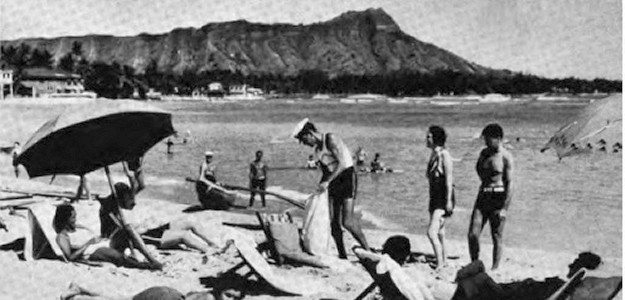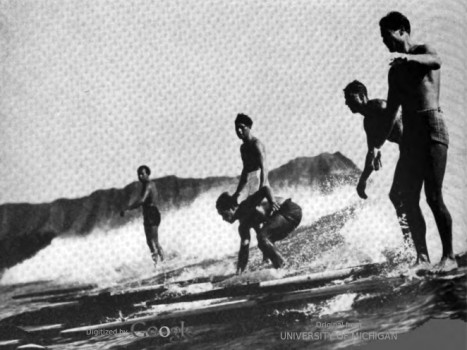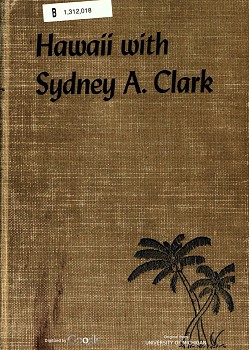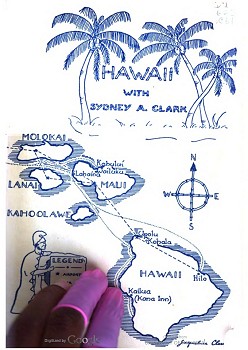surfresearch.com.au
 |
surfresearch.com.au
clark
: hawaiian surfing , 1939
|
Sydney
A. Clark
: Surfriding in Hawaii, 1939.
Extracts
from
Clark,
Sydney:
Hawaii.
Prentice-Hall, New York, 1939.
Hathitrust
http://hdl.handle.net/2027/mdp.39015012879634
Introduction.
One of many tourist guides promoting
the islands for intending visitors, Clark reprises considerable
material from Thomas Thrum's flawed account of surfriding and
surfboard construction in
ancient Hawaii.
Also note that Clark further compounds these errors with a less
than accurate transcription:
The
aristocratic wood was a very light and buoyant variety called
olo ... the
commoners' wood was alaia, page 153.
See:
1896 Thrum* : Hawaiian
Surfriding.
Sydney Clark (1890-1975)
Map illustration by Jacqueline Clark.
Page 42
[A CHAPTER
OF ANSWERS]
About Sports for the Malihini
The water sports of Waikiki are the red letter item on the
roster - especially surf-riding, the national sport of Hawaii.
The subject is too big to mention as a trailer to this brief
{page 43] review.
We shall look into it in a later chapter when we find ourselves
settling into the picture of "the beach."
Page 48
A hard day at
Waikiki.
Page 146
The spirit of
speed at Waikiki.
Page 151
The quarter-million-dollar natatorium of Waikiki needs more than
casual mention.
Built as a tribute to Hawaii's World War heroes, it is called,
and I think fairly, the finest outdoor pool in the world.
Rising from the very sea, its dimensions are forty yards by one
hundred and ten yards and its bleachers seat six thousand
people.
Duke Kahanamoku lent his Olympic prestige to the occasion of its
opening in 1929, and Buster Crabbe here burst into prominence as
a great swimmer.
Important aquatic meets are held each year and you will wish to
scrutinize your calendar to see if one happens to coincide with
your visit.
Page 152
[SUNLIGHT
AND MOONLIGHT AT WAIKIKI]
The Royal
Sport of Surf-Riding
The most deservedly famous feature of Waikiki is the
exhilarating sport of the old kings and chiefs, surf-riding.
Found at various other beaches on the other islands, it nowhere
compares in quality with that at Waikiki, for there a convenient
reef, a third of a mile from shore, creates long rollers ideal
for the sport.
It is not widely known that religious rites played their part in
first instituting this sport and that the universal passion for
gambling kept it alive.
Commoners, even in earliest days, took to it merely as an
exciting competitive sport, but the kings and priests prayed
about it
and consulted their magicians.
When a tree was selected and felled for surfboard material, a
hole was dug at its roots and a red fish, the kumu, thrown into
the hole by way of payment to the gods.
By laborious use of a stone adze the board was fashioned; its
surface was scraped smooth with coral and oahi stone; and
finally the finished product was stained by ti root or painted
with a lustrous black paint obtained from burned kukui roots.
The material for the surfboards was of two distinct types, one
for kings and chiefs, the other for the common run.
The aristocratic wood was a very light and buoyant variety
called olo from the wiliwili tree, so corklike in
floating power that it could not be paddled out against the surf
to the starting line but had to be towed out by canoeists.
These boards were six to eight inches thick.
The commoners' wood was alaia from the koa tree, or the
breadfruit tree, and these boards required only a third or a
quarter of the thickness of the others.
Betting on surfboard races sustained interest for decades and
reached high levels in the stakes risked.
Personal property ranging from fish nets to valuable livestock
was wagered regularly and in some cases liberty and even human
life were offered as backing for the wagerer's own skill or that
of a
Page 153
favorite rider.
The surf meets of olden days must have been permeated with wild
excitement.
Women were often quite as adept at the sport as men, and were
sometimes willing to wager themselves as stakes.
Many a romantic tale, half-buried in legend, has survived a
century and a half.
I suppose the early missionaries must have looked askance at
this sport because of its gambling features.
At any rate it declined and finally died outright, and, strange
as it seems, a haole revived it early in this present century.
He was Alexander Hume Ford of the Chicago Tribune who
organized the Outrigger Club at Waikiki in 1908.
This far-famed club, whose headquarters adjoin the big hotels,
now has members all over the world and is the central school of
the surfing art.
Hawaiians re-learned this art of their ancestors from
interloping haoles, but it is needless to say that they quickly
surpassed their teachers and attained uncanny skill to match
their native ease and grace.
It is thrilling to watch their carefully careless perfection.
The bronzed beach boys are to surfing what Norwegian hill
runners are to the art of skiing.
The technique of surf-riding is simple - once you learn it - as
simple, in fact, as playing the violin.
In other words it is not something you can master in an
afternoon or two, unless you have a wonderful sense of balance
and a bold flair for all things athletic.
Having paddled yourself (with perpendicular arm stroke) out to
the proper point, you lie in wait for a series of rollers that
seems to promise success, then, letting one or two of these
rollers pass, for they will not be sufficiently potent, you
propel yourself furiously shoreward, letting your board catch
the third swell or perhaps the fourth.
If all goes well you soar along, tilted slightly forward, at a
pace that has been estimated at thirty miles an hour.
If all does not go well you miss the roller altogether, or worse
still, lose your grip of the board which nose-dives violently
and
bounces out into the clear.
Having learned to balance your-
Page 154
self on your wooden steed with confidence, the business of
standing up is less hard than it seems.
Beach boys think nothing of carrying a passenger in on their
shoulders or of standing on their heads as they ride in.
The Wahine Surf, near the Moana Hotel, is the "sissy surf" for
beginners, as its name implies; the Cornucopia and Queen Surfs,
farther toward Diamond Head, are trickier and faster; and the
big Castle Surf in front of the Elks' Club is the most dangerous
one,
for experts only.
Surfing in outrigger canoes is a sociable sport, like that of
the toboggan or the old-fashioned double-runner for six or eight
persons.
Even ten or twelve may make the thrilling ride at once, guided
by a steersman on whom the responsibility rests.
The canoes, generally painted black with an inch rail of yellow,
are fifteen to forty feet in length, with two carved timbers
arching to the buoyant float of wiliwili wood on the left. In
general semblance they suggest the ancient peleleus or war
canoes with which Kamehameha and his chiefs went on naval
expeditions, but their size is comparatively diminutive.
The ancient canoe, carved from a single koa tree, had a length
of seventy feet, a depth and beam of three feet, and could hold
three or four score warriors with their trappings and implements
of battle.
Canoe surf-riding may seem a softer sport than surfboarding,
since you are presumably in charge of an expert steersman, but
it is actually no less exciting.
The speed is the same and there is the same delicious danger of
a fierce nose-dive straight to the ocean's floor.
The cost of surf sport is not entirely negligible, but neither
is it prohibitive to the slender purse.
Standard rates for hiring a surfboard are $1 a day; for
instruction (together with the surfboard) $2.50 to $3 an hour.
Outrigger canoes, with steersman, generally cost a minimum of $3
for a half hour's use or $1 per passenger, if there are more
than three.
Longer
Page 155
periods can be arranged by the time-honored process of
dickering.
Moonlight and canoeing are mated by romance in all parts of the
world, but nowhere so perfectly as here at Waikiki, where
spray-drenched racing on the crests of silvered rollers adds
thrill to thrill.
Try it and crackle with the electricity of living.

surfresearch.com.au
Geoff Cater (2016) : Sydney
Clark
: Hawaii, 1939.
http://www.surfresearch.com.au/1939_Clark_Hawaii.html






